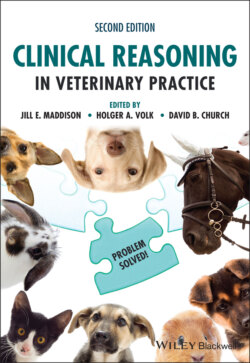Читать книгу Clinical Reasoning in Veterinary Practice - Группа авторов - Страница 89
Define the location
ОглавлениеIn cases of diarrhoea, the problem‐based system we discussed in Chapter 2 is applied, but in a slightly different order. Identification of the location occurs first, which then assists in defining the system. This is because, almost always, large bowel diarrhoea reflects primary GI disease, whereas small bowel diarrhoea can occur with either primary or secondary GI disease. Thus, defining the location first aids in defining the system.
A thorough history is essential to differentiate small from large bowel disease. It is important to carefully question the owner as to the character of the faeces and to elicit information regarding consistency, colour, frequency and presence of blood or mucus. Related abnormalities should also be assessed, such as whether there has been significant weight loss, loss of appetite or vomiting. The characteristics of small and large bowel diarrhoea are detailed in Table 4.1.
Because large bowel diarrhoea has fewer and more specific characteristics than small bowel diarrhoea, it is often easiest to note if there is any fresh blood, mucus and small amounts of faeces passed frequently. If the diarrhoea has none of these characteristics, then the patient has small bowel diarrhoea. Note also that diarrhoea may have features of both small and large bowel, which indicates either primary small bowel with secondary effects on the lower bowel or diffuse disease involving both the small and large intestine.
Table 4.1 Characteristics of small and large bowel diarrhoea.
| Small bowel diarrhoea | Large bowel diarrhoea | |
|---|---|---|
| Consistency, volume and pattern | Faecal volume and/or water content is increased. Diarrhoea may be projectile and does not usually involve significant tenesmus or urgency. | Small amounts of faecal material are passed frequently. Tenesmus and urgency are often present, particularly if the lower colon or the rectum is involved. |
| Blood | If blood is present, it is usually digested (melaena) or, in acute diarrhoea, reddish‐brown. | If blood is present, it will be undigested (haematochezia). |
| Appearance | Colour may be grey if large amounts of undigested fat are present. A yellow‐green coloration is common and due to malabsorbed bile salts. | Mucus is often present either on the surface (indicating the lesion is in the lower colon or rectum) or throughout the faeces (indicating a lesion in the higher colon). |
| Weight loss | Chronic small bowel diarrhoea is often (but not always) associated with weight loss. | Usually there is no weight loss caused by large bowel diarrhoea per se but there may be as a result of the pathology such as severe inflammation or neoplasia. |
| Vomiting | Vomiting may also be present (but need not be). Relationship to eating can be variable depending on the location of the lesion. | Vomiting can occur occasionally but is infrequent and is unrelated to eating. |
| Borborygmus and flatulence | Gas commonly occurs with small bowel diarrhoea, as malabsorbed carbohydrates are fermented by colonic bacteria producing CO2 and H2S. | Uncommon. |
| Appetite | Appetite may be variable depending on the underlying aetiology. | Usually, the appetite is unaffected. |
| Water balance | If the diarrhoea is severe, the animal may be dehydrated. If the diarrhoea is very watery, the patient may have an increased water intake. | Large bowel diarrhoea per se does not usually adversely affect water balance. |
| Physical examination | Physical examination may reveal increased gas or thickened loops of bowel but is often unrewarding. Always do a rectal examination to check for melaena or large bowel signs such as mucus and fresh blood about which the owner may not be aware. | Physical examination is often unremarkable, but it is imperative to do a rectal examination if possible to check for strictures, masses or thickened mucosa. |
